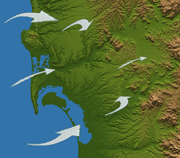|  early every afternoon, onshore ocean breezes push pollution against the
coastal ranges around San Diego. Emissions from motor vehicles and industry
are generated in the populated coastal plain and blown inland by the onshore
breezes to the lower mountain slopes.
early every afternoon, onshore ocean breezes push pollution against the
coastal ranges around San Diego. Emissions from motor vehicles and industry
are generated in the populated coastal plain and blown inland by the onshore
breezes to the lower mountain slopes.
At night, the process reverses, taking it back towards the ocean. The
next day, the cycle begins again and continues until weather patterns
change. This collection of trapped pollutants pushes against mountain
slopes on a daily basis and in the intense sunlight react together to
create ozone, the main ingredient of smog. This photochemical process
peaks in the afternoon, when sun is most abundant, and smog hovers around
2,000 feet.
 When conditions are right, a temperature inversion layer, or a kind of
lid, is formed when warm, dry air overlies cool, moist marine air. The
layers cannot mix. The inversion layer traps pollutants against the slopes
and prevents them from rising over the mountains. This inversion layer
traps both local and transported dirty air.
When conditions are right, a temperature inversion layer, or a kind of
lid, is formed when warm, dry air overlies cool, moist marine air. The
layers cannot mix. The inversion layer traps pollutants against the slopes
and prevents them from rising over the mountains. This inversion layer
traps both local and transported dirty air.
Organized wind patterns in the summer cause "Santa Ana" weather
conditions. Winds blowing toward the southwest transport polluted air
from the South Coast Air Basin (the
metropolitan areas of Los Angeles, Orange, San Bernardino, and Riverside
Counties) out over the ocean, and the sea breeze brings it onshore into
San Diego County. The winds create an eddy or swirl-like pattern that
circulates around the coastal area and is blown farther inland.
The typical wind flow pattern fluctuates with occasional winter storms.
In the winter, the winds are slower and don't blow in a prevailing direction
so there is no eddy pattern. But because of the low angle of the sun,
inversions hang around even longer trapping pollution until the weather
changes.
 Next - The largest emitters of air pollution...
Next - The largest emitters of air pollution...
|

Click to See More about Air Flow & Geography

Eye-opening Fact...
Because of unique topography, a large population and nearly one car per person, California still has eight of the 10 smoggiest cities in the U.S.
Overview
 Air Transport Corridors Air Transport Corridors
 Pollution Sources Pollution Sources
 Criteria Pollutants Criteria Pollutants
 Meteorology Meteorology
 Visibility Visibility
 Acid
Rain/Snow Acid
Rain/Snow
 Air
Pollution Advisories Air
Pollution Advisories
|


